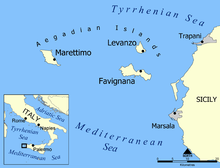| Revision as of 19:37, 21 June 2010 editSionix (talk | contribs)6 editsNo edit summary← Previous edit | Revision as of 19:40, 21 June 2010 edit undoSionix (talk | contribs)6 editsNo edit summaryNext edit → | ||
| Line 13: | Line 13: | ||
| There is a well restored Byzantine-Norman church adjacent to the Casa Romana. | There is a well restored Byzantine-Norman church adjacent to the Casa Romana. | ||
| There are several impressive grottos around the islands coast and innumerable spots for excellent swimming in pristine waters. | There are several impressive grottos around the islands coast and innumerable spots for excellent swimming in pristine waters on the western coast accessible only by boat. | ||
| ==Flora of Marettimo== | ==Flora of Marettimo== | ||
| Line 19: | Line 19: | ||
| ==Fauna of Marettimo== | ==Fauna of Marettimo== | ||
| There is a sizeable |
There is a sizeable population of donkeys and horses on the island. There are wild goats, rabbits, eagles, falcons and plenty of screeching gulls. | ||
| ==Gallery== | ==Gallery== | ||
Revision as of 19:40, 21 June 2010
37°58′10″N 12°03′26″E / 37.96944°N 12.05722°E / 37.96944; 12.05722

Marettimo (Coordinates: 37°58' north; 12°4' east) (Sicilian: Marrètimu) is one of the Aegadian Islands in the Mediterranean Sea west of Sicily, Italy. It forms a part of the municipality (comune) of Favignana in the Province of Trapani. From Trapani, the island takes about an hour to reach.
Marettimo is the second largest of the Aegadian Islands. The highest point is Monte Falcone with a height of 686 m (2,287 ft). The island has about 300 inhabitants in the winter and 700 in the summer (not including tourists), who mainly live from fishing and traditional hand-craft. Fishing is predominately conducted in the summer months.
The ancient name of the island was "Hiera", perhaps a term of Spanish origin. However, the name "Hiera" is part of the Greek name "Hiera Nesos", which means "Sacred Island" in Greek.
The name Marettimo comes from the words Mar (Sea) and Timo (Thyme) due to the profusion of thyme on the island.
The island was an important observation point during Roman times, hence the Casa Romana, where it was easy observe passing maritime traffic. The sea routes between Italy and North Africa and Italy and Spain (via Sardinia) would pass Marettimo.
There is a well restored Byzantine-Norman church adjacent to the Casa Romana.
There are several impressive grottos around the islands coast and innumerable spots for excellent swimming in pristine waters on the western coast accessible only by boat.
Flora of Marettimo
The island comprises about 500 species, many of them are very rare and endemic plant, among the most endangered plant: Bupleurum dianthifolium, Brassica macrocarpa, Scilla hughii and Thymus richardii subsp. nitidus, the last one was chemically investigated
Fauna of Marettimo
There is a sizeable population of donkeys and horses on the island. There are wild goats, rabbits, eagles, falcons and plenty of screeching gulls.
Gallery
-
 The ruins of the "Casa Romana" settlement.
The ruins of the "Casa Romana" settlement.
- Moorish castle on the northern promontory. Moorish castle on the northern promontory.
-
 From a ridge above town: Scala Vecchio on the left, Scala Nuovo on the right, and the "Casa Romana" visible in the left foreground.
From a ridge above town: Scala Vecchio on the left, Scala Nuovo on the right, and the "Casa Romana" visible in the left foreground.
References
- Ammar Bader, Guido Flamini, Pier Luigi Cioni and Ivano Morelli, Journal of Essential Oils Research, Vol 13 pp.8-10
This Sicilian location article is a stub. You can help Misplaced Pages by expanding it. |